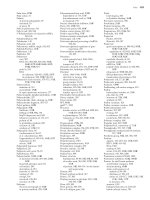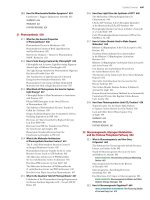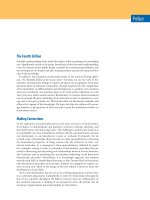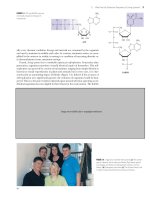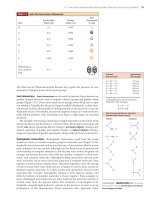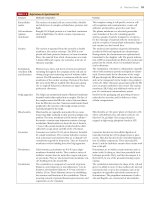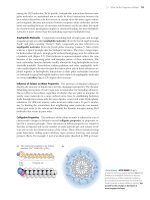Biochemistry, 4th Edition P4 docx
Bạn đang xem bản rút gọn của tài liệu. Xem và tải ngay bản đầy đủ của tài liệu tại đây (353.86 KB, 10 trang )
Preface
The Fourth Edition
Scientific understanding of the molecular nature of life is growing at an astounding
rate. Significantly, society is the prime beneficiary of this increased understanding.
Cures for diseases, better public health, remedies for environmental pollution, and
the development of cheaper and safer natural products are just a few practical ben-
efits of this knowledge.
In addition, this expansion of information fuels, in the words of Thomas Jeffer-
son, “the illimitable freedom of the human mind.” Scientists can use the tools of bio-
chemistry and molecular biology to explore all aspects of an organism—from basic
questions about its chemical composition, through inquiries into the complexities
of its metabolism, its differentiation and development, to analysis of its evolution
and even its behavior. New procedures based on the results of these explorations lie at the
heart of the many modern medical miracles. Biochemistry is a science whose boundaries
now encompass all aspects of biology, from molecules to cells, to organisms, to ecol-
ogy, and to all aspects of health care. This fourth edition of Biochemistry embodies and
reflects the expanse of this knowledge. We hope that this new edition will encour-
age students to ask questions of their own and to push the boundaries of their cu-
riosity about science.
Making Connections
As the explication of natural phenomena rests more and more on biochemistry,
its inclusion in undergraduate and graduate curricula in biology, chemistry, and
the health sciences becomes imperative. The challenge to authors and instructors
is a formidable one: how to familiarize students with the essential features of mod-
ern biochemistry in an introductory course or textbook. Fortunately, the in-
creased scope of knowledge allows scientists to make generalizations connecting
the biochemical properties of living systems with the character of their con-
stituent molecules. As a consequence, these generalizations, validated by repeti-
tive examples, emerge in time as principles of biochemistry, principles that are
useful in discerning and describing new relationships between diverse biomolec-
ular functions and in predicting the mechanisms underlying newly discovered
biomolecular processes. Nevertheless, it is increasingly apparent that students
must develop skills in inquiry-based learning, so that, beyond this first encounter
with biochemical principles and concepts, students are equipped to explore sci-
ence on their own. Much of the design of this new edition is meant to foster the
development of such skills.
We are both biochemists, but one of us is in a biology department, and the other
is in a chemistry department. Undoubtedly, we each view biochemistry through the
lens of our respective disciplines. We believe, however, that our collaboration on
this textbook represents a melding of our perspectives that will provide new di-
mensions of appreciation and understanding for all students.
xxviii Preface
Our Audience
This biochemistry textbook is designed to communicate the fundamental principles
governing the structure, function, and interactions of biological molecules to stu-
dents encountering biochemistry for the first time. We aim to bring an appreciation
of biochemistry to a broad audience that includes undergraduates majoring in the
life sciences, physical sciences, or premedical programs, as well as medical students
and graduate students in the various health sciences for whom biochemistry is an
important route to understanding human physiology. To make this subject matter
more relevant and interesting to all readers, we emphasize, where appropriate, the
biochemistry of humans.
Objectives and Building on Previous Editions
We carry forward the clarity of purpose found in previous editions; namely, to illu-
minate for students the principles governing the structure, function, and interac-
tions of biological molecules. At the same time, this new edition has been revised to
reflect tremendous developments in biochemistry. Significantly, emphasis is placed
on the interrelationships of ideas so that students can begin to appreciate the over-
arching questions of biochemistry.
Features
• Clarity of Instruction This edition was streamlined for increased clarity and read-
ability. Many of the lengthier figure legends were shortened and more informa-
tion was included directly within illustrations. These changes will help the more
visual reader.
• Visual Instruction The richness of the Protein Data Bank (www.pdb.org) and
availability of molecular graphics software has been exploited to enliven this text.
Over 330 images of prominent proteins and nucleic acids involved with essential
biological functions illustrate and inform the subject matter and were prepared
especially for this book.
• New End-of-Chapter Problems More than 600 end-of-chapter problems are pro-
vided, about 15 percent of which are new. They serve as meaningful exercises
that help students develop problem-solving skills useful in achieving their learn-
ing goals. Some problems require students to employ calculations to find math-
ematical answers to relevant structural or functional questions. Other questions
address conceptual problems whose answers require application and integration
of ideas and concepts introduced in the chapter. Each set of problems concludes
with MCAT practice questions to aid students in their preparation for standard-
ized examinations such as the MCAT or GRE.
• Human Biochemistry essays emphasize the central role of basic biochemistry in
medicine and the health sciences. These essays often present clinically important
issues such as diet, diabetes, and cardiovascular health.
• A Deeper Look essays expand on the text, highlighting selected topics or exper-
imental observations.
• Critical Developments in Biochemistry essays emphasize recent and historical
advances in the field.
• Up-to-Date References at the end of each chapter make it easy for students to
find additional information about each topic.
• Laboratory Techniques The experimental nature of biochemistry is highlighted,
and a list of laboratory techniques found in this book can be seen on page xxvi.
• Essential Questions Each chapter in this book is framed around an Essential
Question that invites students to become actively engaged in their learning, and
encourages curiosity and imagination about the subject matter. For example, the
Essential Question of Chapter 3 asks, “What are the laws and principles of ther-
modynamics that allow us to describe the flows and interchange of heat, ener
gy,
Preface xxix
and matter in systems of interest?” The section heads then pose key questions
such as, “What Is the Daily Human Requirement for ATP?” The end-of-chapter
summary then brings the question and a synopsis of the answer together for the
student. In addition, the CengageNOW site at www.cengage.com/login expands
on this Essential Question theme by asking students to explore their knowledge
of key concepts.
• Key Questions The section headings within chapters are phrased as important
questions that serve as organizing principles for a lecture. The subheadings are
designed to be concept statements that respond to the section headings.
• Text-to-Web Instruction Through icons in the margins, in figure legends, and
within boxes, students are encouraged to further test their mastery of the Essen-
tial and Key Questions and to explore interactive tutorials and animations at
CengageNOW at www.cengage.com/login.
• Linking Key Questions to Chapter Summaries The end-of-chapter summaries recite
the key questions posed as section heads and then briefly summarize the important
concepts and facts to aid students in organizing and understanding the material.
• Active and Animated Figures at CengageNOW Many text figures, labeled Active
(Figure 3.1) or Animated (Figure 3.5), can be found at www.cengage.com/login.
Active Figures have corresponding test questions where students can quiz them-
selves on the concepts of the figures. Animated Figures give life to the art by al-
lowing students to watch the progress of an animation. This site also includes
“Essential Questions” for Biochemistry. These questions are open-ended and can
be assigned as student projects by instructors. This website also includes instruc-
tor PowerPoint slides with embedded animations/simulations as well as molecu-
lar movies for the classroom.
New to This Edition
Biochemistry is an ever-expanding discipline and new research leads to expanding
our knowledge. This edition highlights the newest developments in the field.
Chapter 5 Analysis of amino acid sequence information from genomic databases re-
veals functional relationships between proteins, as well as their evolutionary history.
Chapter 6 The discussion of protein structure now includes protein structure clas-
sification databases (SCOP and CATH); the flexible, marginally stable nature of
proteins; expanded coverage of intrinsically unstructured proteins; and special fea-
tures, such as the molecular mousetrap (α
1
-antitrypsin).
Chapter 7 Glycomics and the structural code of carbohydrates; galectins as media-
tors of inflammation, immunity, and cancer; and C-reactive protein, a lectin that
limits inflammation damage, highlight this chapter.
Chapter 8 Discussions of healthy dietary oils and fats, including canola oil and
Benecol, the novel lipids in archaea, lipids as signals, and lipidomics as a framework
for understanding the many roles of lipids are now included.
Chapter 9 New concepts of membrane structure, function, and dynamics, and the
recently solved structures of membrane channel proteins, active transport proteins,
and ABC transporters are featured.
Chapter 10 The exciting prospects for DNA nanodevices and the applied science of
nanotechnology are reviewed, and the evolution of contemporary life from an RNA-
based world is presented.
Chapter 11 Nucleic acid sequencing by automated, fluorescence-based or light-
emitting techniques has made possible sequencing the DNA of individuals. The
structure of DNA multiplexes composed of 3 or 4 polynucleotide strands and the
higher orders of structure in RNA molecules are new topics in this chapter.
Chapter 12 The use of RNA interference (RNAi) as a tool to discover gene function
and various analytical methods for probing protein-protein interaction are two new
methodologies pertinent to this chapter.
xxx Preface
Chapter 13 The possibility of creating enzymes designed to catalyze any desired re-
action is introduced.
Chapter 14 Enzyme mechanisms (Chapter 14 Mechanisms of Enzyme Action) are pre-
sented before enzyme regulation (Chapter 15 Enzyme Regulation), allowing students
to appreciate the catalytic power of enzymes immediately after learning about their
kinetic properties (Chapter 13 Enzymes—Kinetics and Specificity). The coverage of en-
zyme mechanisms has been reorganized, shortened, and simplified in this chapter.
New topics added in this chapter include medical and commercial applications of
enzyme transition state analogs, a primer on how to read and write enzyme mecha-
nisms, the roles of near-attack complexes and protein motion in enzyme catalysis,
and a new feature on chorismate mutase.
Chapter 15 The regulation of enzyme activity through allosteric mechanisms is pre-
sented in a simplified and integrated form, and the different covalent modifications
that alter protein function are characterized.
Chapter 16 The chapter provides substantially revised discussions of myosin, ki-
nesin, and dynein motors; an updated discussion of helicases, including the papil-
loma virus E1 helicase spiral staircase; and new information on the flagellar rotor
structure and mechanism.
Chapter 17 The emerging science of metabolomics and systems biology highlight
this chapter.
Chapter 18 The significance of glycolysis to overall metabolism is illustrated
through a discussion of hypoxia inducible factor (HIF), a protein that acts in the
absence of oxygen to activate transcription of genes for glycolytic enzymes.
Chapter 19 Discussion of the TCA cycle has been updated and a new “A Deeper
Look” box on the coenzymes of the TCA cycle has been added.
Chapter 20 The chapter now includes discussions of the structures of the electron
transport complexes, the ATP synthase as a rotational molecular motor that uses the
energy of a proton gradient to drive synthesis of ATP, and the role of mitochondria
in cell signaling and apoptosis.
Chapter 21 The structural details of the photosystems that transduce light ener
gy
into chemical energy have given new insights into photosynthesis.
Chapter 22 The identity of xylulose-5-phosphate as a metabolic regulator is a new
feature in this chapter.
Chapter 23 This chapter is enhanced by new information on the structure and func-
tion of the enzymes of -oxidation, therapeutic effects of exercise in reversing the
consequences of metabolic syndrome, and natural antioxidants in foods that can
improve fat metabolism.
Chapter 24 The recent revelation that megasynthases catalyze fatty acid synthesis in
eukaryotes is presented in this chapter, along with new information on the structure
and function of the LDL receptor.
Chapter 25 Relationships between amino acid metabolism and human disease, such
as the significance of aspargine to leukemia, are underscored.
Chapter 26 The phenomenon of metabolic channeling as a principle in metabolic
organization and integration is emphasized.
Chapter 27 The role of AMP-activated protein kinase as the sensor of cellular en-
ergy levels and regulator of whole-body energy homeostasis is introduced, and the
biochemical connections between caloric restriction or red wine consumption to
prolonged lifespan are explored.
Chapter 29 The structural studies of RNA polymerase that brought Roger Kornberg
the Nobel Prize form the basis for a deeper understanding of transcription. Also
presented are chromatin remodeling and histone modifications as processes deter-
mining the accessibility of chromatin to the transcriptional apparatus.
Chapter 30 Recent discoveries regarding the molecular structure of ribosomes have
provided new insights about the mechanisms by which they synthesize proteins.
Preface xxxi
Chapter 31 The descriptions of protein folding include new information on how
ATP drives and regulates protein folding by chaperonins. It is now clear that AAAϩ
ATPase modules mediate the unfolding of proteins in the proteasome. Small,
ubiquitin-like protein modules (SUMOs) are presented as key modifiers in the post-
translational regulation of protein function.
Chapter 32 The chapter has been substantially revised and reorganized to consoli-
date information on membrane receptor structure and function. Included here is
new material about the epidermal growth factor receptor, the insulin receptor, and
the atrial natriuretic peptide receptor, as well as the organization and integration
of cell signaling pathways and the action of G-protein-coupled receptors through
G-protein-independent pathways.
Complete Support Package
For Students
Student Solutions Manual, Study Guide and Problems Book by David K. Jemiolo
(Vassar College) and Steven M. Theg (University of California, Davis) includes sum-
maries of the chapters, detailed solutions to all end-of-chapter problems, a guide to
key points of each chapter, important definitions, and illustrations of major meta-
bolic pathways. (0-495-11460-X)
Student Lecture Notebook Perfect for note taking during lecture, this conve-
nient booklet consists of black and white reproductions of the PowerPoint slides.
(0-495-11461-8)
CengageNOW at www.cengage.com/login CengageNOW’s online self-assessment
tool is developed specifically for this text, extending the “Essential Questions”
framework. You can explore a variety of tutorials, exercises, and simulations
(cross-referenced throughout the text with margin annotations). You can also
take chapter-specific Pre-Tests and receive a Personalized Study plan that directs
you to specific interactive materials that can help you master areas where you
need additional work. Access to CengageNOW for two semesters may be included
with new textbooks or may be purchased at www.ichapters.com using ISBN 0-495-
60645-6. Instructors, please contact your Cengage Learning representative for
bundling information.
For Professors
PowerLecture with ExamView
Instructor’s Resource CD-ROM ISBN: 0-495-11459-6
PowerLecture is a one-stop digital library and presentation tool that includes:
• Prepared Microsoft
®
PowerPoint
®
Lecture Slides covering all key points from the
text in a convenient format that you can enhance with your own materials or with
additional interactive video and animations from the CD-ROM for personalized,
media-enhanced lectures.
• Image Libraries in PowerPoint or in JPEG format that contain electronic files for
all text art, most photographs, and all numbered tables in the text. These files
can be used to print transparencies.
• Electronic files for the Test Bank.
• Sample chapters from the Student Solutions Manual, Study Guide, and Problems
Book and the Lecture Notebook.
• ExamView
®
testing software, with all the test items from the Online Test Bank in
electronic format, which enables you to create customized tests of up to 250
items in print or online.
xxxii Preface
OnlineTest Bank by Larry Jackson, Montana State University
Includes 25–40 multiple-choice questions per chapter for professors to use as tests,
quizzes, or homework assignments. Electronic files for the Test Bank are available
on the PowerLecture Instructor’s CD-ROM. BlackBoard and WebCT formatted files
for the Test Bank can be found on the faculty companion site for this book at
www.cengage.com/chemistry/garrett. (0-495-11457-X)
Acknowledgments
We are indebted to the many experts in biochemistry and molecular biology who
carefully reviewed this book at several stages for their outstanding and invaluable
advice on how to construct an effective textbook.
Guillaume Chanfreau
University of California, Los Angeles
Jeffrey Cohlberg
California State University, Long Beach
Bansidhar Datta
Kent State University
Clyde Denis
University of New Hampshire
Gregg B. Fields
Florida Atlantic University
Eric Fisher
University of Illinois, Springfield
Nancy Gerber
San Francisco State University
Donavan Haines
University of Texas, Dallas
Nicole Horenstein
University of Florida
Gary Kunkel
Texas A&M University
Scott Lefler
Arizona State University
Susanne Nonekowski
University of Toledo
Wendy Pogozelski
State University of New York, Geneseo
Michael Reddy
University of Wisconsin
Mary Rigler
California Polytechnic State University
Huiping Zhou
Virginia Commonwealth University
Brent Znosko
St. Louis University
We also wish to warmly and gratefully acknowledge many other people who assisted
and encouraged us in this endeavor. A special thank you to Scott Lefler, Arizona
State University, who read page proofs with an eye for accuracy. This book remains
a legacy of Publisher John Vondeling, who originally recruited us to its authorship.
We sense his presence still nurturing our book and we are grateful for it. Lisa Lock-
wood, our new publisher, has brought enthusiasm and an unwavering emphasis on
student learning as the fundamental purpose of our collective endeavor. Sandi
Kiselica, Senior Developmental Editor, is a biochemist in her own right. Her fasci-
nation with our shared discipline has given her a particular interest in our book and
a singular purpose: to keep us focused on the matters at hand, the urg
encies of the
schedule, and limits of scale in a textbook’s dimensions. The dint of her efforts has
been a major factor in the fruition of our writing projects. She is truly a colleague
in these endeavors. We also applaud the unsung but absolutely indispensable con-
tributions by those whose efforts transformed a rough manuscript into this final
product: Teresa Trego, project manager; Carol O’Connell, production editor; Lisa
Weber, media editor; and Ashley Summers, assistant editor. If this book has visual
appeal and editorial grace, it is due to them. The beautiful illustrations that not only
decorate this text, but explain its contents are a testament to the creative and taste-
ful work of Cindy Geiss, Director of Graphic World Illustration Studio, and to the
legacy of John Woolsey and Patrick Lane at J/B Woolsey Associates. We are thank-
ful to our many colleagues who provided original art and graphic images for this
work, particularly Professor Jane Richardson of Duke University. We are eager to ac-
knowledge the scientific and artistic contributions of Michal Sabat, Senior Scientist
Preface xxxiii
in the Department of Chemistry at the University of Virginia. Michal was the creator
of most of the PyMOL-based molecular graphics in this book. Much of the visual ap-
peal that you will find in these pages gives testimony to his fine craftsmanship and
his unflagging dedication to our purpose. We owe a very special thank-you to Rose-
mary Jurbala Grisham, devoted spouse of Charles and wonderfully tolerant friend
of Reg. Also to be acknowledged with love and pride are Georgia Grant, to whom
this book is also dedicated, and our children, Jeffrey, Randal, and Robert Garrett,
and David, Emily, and Andrew Grisham. Also to be appreciated are Jatszi, Jazmine,
and Jasper, three Hungarian Pulis whose unseen eyes view life with an energetic cu-
riosity we all should emulate. Memories of Clancy, a Golden Retriever of epic pa-
tience and perspicuity, are companions to our best thoughts. We hope this fourth
edition of our textbook has captured the growing sense of wonder and imagination
that researchers, teachers, and students share as they explore the ever-changing
world of biochemistry.
“Imagination is more important than knowledge. For while knowledge defines all
we currently know and understand, imagination points to all we might yet discover
and create.”
—Albert Einstein
Reginald H. Garrett Charles M. Grisham
Charlottesville, VA Ivy, VA
December 2008
This page intentionally left blank
© Dennis Wilson/CORBIS
1
The Facts of Life: Chemistry
Is the Logic of Biological
Phenomena
Molecules are lifeless. Yet, in appropriate complexity and number, molecules com-
pose living things. These living systems are distinct from the inanimate world because
they have certain extraordinary properties. They can grow, move, perform the in-
credible chemistry of metabolism, respond to stimuli from the environment, and
most significantly, replicate themselves with exceptional fidelity. The complex struc-
ture and behavior of living organisms veil the basic truth that their molecular consti-
tution can be described and understood. The chemistry of the living cell resembles
the chemistry of organic reactions. Indeed, cellular constituents or biomolecules
must conform to the chemical and physical principles that govern all matter. Despite
the spectacular diversity of life, the intricacy of biological structures, and the com-
plexity of vital mechanisms, life functions are ultimately interpretable in chemical
terms. Chemistry is the logic of biological phenomena.
1.1 What Are the Distinctive Properties of Living Systems?
First, the most obvious quality of living organisms is that they are complicated and
highly organized (Figure 1.1). For example, organisms large enough to be seen with
the naked eye are composed of many cells, typically of many types. In turn, these
cells possess subcellular structures, called organelles, which are complex assem-
blies of very large polymeric molecules, called macromolecules. These macro-
molecules themselves show an exquisite degree of organization in their intricate
Sperm approaching an egg.
“…everything that living things do can be under-
stood in terms of the jigglings and wigglings
of atoms.”
Richard P. Feynman
Lectures on Physics, Addison-Wesley, 1963
KEY QUESTIONS
1.1 What Are the Distinctive Properties
of Living Systems?
1.2 What Kinds of Molecules Are Biomolecules?
1.3 What Is the Structural Organization of
Complex Biomolecules?
1.4 How Do the Properties of Biomolecules
Reflect Their Fitness to the Living
Condition?
1.5 What Is the Organization and Structure
of Cells?
1.6 What Are Viruses?
ESSENTIAL QUESTION
Molecules are lifeless.Yet, the properties of living things derive from the properties
of molecules.
Despite the spectacular diversity of life, the elaborate structure of biological
molecules, and the complexity of vital mechanisms, are life functions ulti-
mately interpretable in chemical terms?
This icon, appearing throughout
the book, indicates an opportunity to explore inter-
active tutorials and animations and test your knowl-
edge for a quiz or an exam. Sign in at CengageNOW
at www.cengage.com/login
(a)
(b)
Thomas C. Boydon/Marie Selby Botanical Gardens
© Herbert Kehrer/zefa/Corbis
FIGURE 1.1 (a) Gelada (Theropithecus gelada), a baboon native to the Ethiopian highlands. (b) Tropical orchid
(Bulbophyllum blumei), New Guinea.
2 Chapter 1 The Facts of Life: Chemistry Is the Logic of Biological Phenomena
three-dimensional architecture, even though they are composed of simple sets of
chemical building blocks, such as sugars and amino acids. Indeed, the complex
three-dimensional structure of a macromolecule, known as its conformation, is a
consequence of interactions between the monomeric units, according to their in-
dividual chemical properties.
Second, biological structures serve functional purposes. That is, biological structures
play a role in the organism’s existence. From parts of organisms, such as limbs and
organs, down to the chemical agents of metabolism, such as enzymes and metabolic
intermediates, a biological purpose can be given for each component. Indeed, it is
this functional characteristic of biological structures that separates the science of bi-
ology from studies of the inanimate world such as chemistry, physics, and geology. In
biology, it is always meaningful to seek the purpose of observed structures, organiza-
tions, or patterns, that is, to ask what functional role they serve within the organism.
Third, living systems are actively engaged in energy transformations. Maintenance of the
highly organized structure and activity of living systems depends on their ability to
extract energy from the environment. The ultimate source of energy is the sun. So-
lar energy flows from photosynthetic organisms (organisms able to capture light en-
ergy by the process of photosynthesis) through food chains to herbivores and ulti-
mately to carnivorous predators at the apex of the food pyramid (Figure 1.2). The
biosphere is thus a system through which energy flows. Organisms capture some of
this energy, be it from photosynthesis or the metabolism of food, by forming special
energized biomolecules, of which ATP and NADPH are the two most prominent ex-
amples (Figure 1.3). (Commonly used abbreviations such as ATP and NADPH are
defined on the inside back cover of this book.) ATP and NADPH are energized bio-
molecules because they represent chemically useful forms of stored energy. We ex-
plore the chemical basis of this stored energy in subsequent chapters. For now, suf-
fice it to say that when these molecules react with other molecules in the cell, the
energy released can be used to drive unfavorable processes. That is, ATP, NADPH,
and related compounds are the power sources that drive the energy-requiring activ-
ities of the cell, including biosynthesis, movement, osmotic work against concentra-
tion gradients, and in special instances, light emission (bioluminescence). Only
upon death does an organism reach equilibrium with its inanimate environment.
The living state is characterized by the flow of energy through the organism. At the expense
of this energy flow, the organism can maintain its intricate order and activity far re-
moved from equilibrium with its surroundings, yet exist in a state of apparent con-
stancy over time. This state of apparent constancy, or so-called steady state, is actu-
hν
Carnivores
2° Consumers
1° Consumers
1° Producers
Carnivore product (0.4 g)
Herbivore product (6 g)
Primary productivity (270 g)
Herbivores
Photosynthesis
Productivity per square meter of a Tennessee field
FIGURE 1.2 The food pyramid. Photosynthetic organisms at the base capture light energy. Herbivores and car-
nivores derive their energy ultimately from these primary producers.
Entropy is a thermodynamic term used to desig-
nate that amount of energy in a system that is
unavailable to do work.

